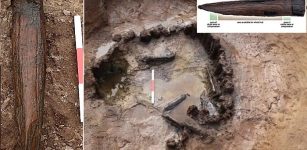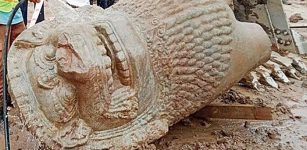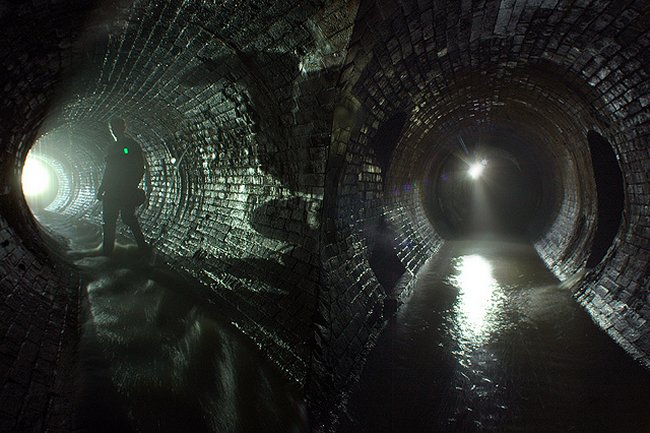London’s Underground Rivers Were Deliberately Hidden
Ellen Lloyd - AncientPages.com - When you think of London, many things come to mind, but not the fact that many hidden underground rivers flow beneath the significant capital of the UK.
Traces of London's lost rivers are visible throughout the city, if you know what to look for Photo: SF Said
Below the ground is a vast network of tunnels and chambers, put in place by Victorian engineers, the final step in a process which took centuries.
London once needed all the rivers it could get: for drinking water, for harbors and wharves, for mills, for tanneries, and for sluicing away waste. The rivers were London's sewage system long before any system was built. Still, even tiny medieval London was too much for any stream to cope with, and many inner London waterways remained deliberately hidden.
The Fleet is probably one of the better-known rivers located beneath Londoners' feet.
Vestiges of it can be traced above ground by following a modest stream that flows from Hampstead and Highgate Ponds in north London.
 The Victorian brickwork from Joseph Bazalgette's sewer system remains in a preserved state. Image credit: Emma Lynch BBC
The Victorian brickwork from Joseph Bazalgette's sewer system remains in a preserved state. Image credit: Emma Lynch BBC
Today it is swiftly submerged, becoming a sewer that flows to Blackfriars Bridge on the River Thames.
During Medieval times the waters of the Fleet were renowned for being clean.
As London city grew, mills, tanneries, and meat markets appeared along its banks. Water was vital to keep these industries functioning and growing.
Gradually, however, the river was polluted with blood, sewage, and other waste, so it became a waste tip, an easily accessible repository to discard anything unwanted, including the carcasses of dead livestock.
Image Credit Flickr User sub-urban.com
London's origins are deep in the Walbrook, the river around which the Romans founded the city. The debris dug from the river – hoes and plow shares, chisels and saws, scalpels and spatulas, the heads of forgotten gods, and a collection of 48 human skulls tell the earliest London tales.
As a result, over the years, the river became shallower and the water much slower than in previous generations, only exacerbating the burgeoning problem of the health hazard it now presented. It would silt up in the summer, and although the spas and wells upstream remained open and functioning, the Fleet in London became an open sewer with a mix of slums and prisons on its banks. Something had to be done.
 The Walbrook's name derives from the fact the brook passed by the Roman city's wall. Image credit: Alan Sorrell/Museum of London
The Walbrook's name derives from the fact the brook passed by the Roman city's wall. Image credit: Alan Sorrell/Museum of London
A solution was urgently needed. The architect Sir Christopher Wren was afforded the chance of transforming the lower Fleet. The Great Fire of London in 1666 provided that opportunity.
The river was channeled underground in the 1730s from Holborn to Fleet Street, which still bears its name. Decades later, it was filled in and arched over from Fleet Street down to the river Thames and is covered by what is now New Bridge Street.
Perhaps, the rivers are hidden, but they are far from gone. It is tough to stop a river from flowing, so they have merely been diverted into the sewer system.
Written by - Ellen Lloyd – AncientPages.com
Copyright © AncientPages.com All rights reserved. This material may not be published, broadcast, rewritten or redistributed in whole or part without the express written permission of AncientPages.com
Expand for referencesMore From Ancient Pages
-
 The Real Paleo Diet: New Archaeological Evidence Changes What We Thought About How Ancient Humans Prepared Food
Featured Stories | Nov 28, 2022
The Real Paleo Diet: New Archaeological Evidence Changes What We Thought About How Ancient Humans Prepared Food
Featured Stories | Nov 28, 2022 -
 ‘Exceptionally’ Rare Iron Age Axle Found In Suffolk
Archaeology | Jan 26, 2023
‘Exceptionally’ Rare Iron Age Axle Found In Suffolk
Archaeology | Jan 26, 2023 -
 The Indigenous Artists Keeping Ancient Rock Art Traditions Alive For Future Generations
Archaeology | Oct 3, 2024
The Indigenous Artists Keeping Ancient Rock Art Traditions Alive For Future Generations
Archaeology | Oct 3, 2024 -
 Ostrich Eggs Dated More Than 4,000 Years Discovered In Negev Desert Of Southern Israel
Archaeology | Jan 13, 2023
Ostrich Eggs Dated More Than 4,000 Years Discovered In Negev Desert Of Southern Israel
Archaeology | Jan 13, 2023 -
 Archaeologists Discover Gloucestershire’s Hidden Treasures
Archaeology | May 14, 2024
Archaeologists Discover Gloucestershire’s Hidden Treasures
Archaeology | May 14, 2024 -
 Prehistoric Spread Of Millet From East Asia To Central Europe – New Study
Archaeology | Jun 10, 2022
Prehistoric Spread Of Millet From East Asia To Central Europe – New Study
Archaeology | Jun 10, 2022 -
 Ancient Roman Coins Thought To Be Fakes Are Authentic – Experts Say
Archaeology | Nov 23, 2022
Ancient Roman Coins Thought To Be Fakes Are Authentic – Experts Say
Archaeology | Nov 23, 2022 -
 Unique Medieval Cog Shipwrecks And Artifacts Found In Sweden
Archaeology | Dec 3, 2022
Unique Medieval Cog Shipwrecks And Artifacts Found In Sweden
Archaeology | Dec 3, 2022 -
 Extraterrestrial Visit Recorded On Stone: They Came From The Stars
Featured Stories | May 4, 2014
Extraterrestrial Visit Recorded On Stone: They Came From The Stars
Featured Stories | May 4, 2014 -
 Dura-Europos Roman Shield Created With Ancient Painting Techniques On Wood
Archaeology | Nov 9, 2015
Dura-Europos Roman Shield Created With Ancient Painting Techniques On Wood
Archaeology | Nov 9, 2015 -
 In The Neanderthal Site Of Combe-Grenal, France: Hunting Strategies Were Unaffected By Changing Climate
Archaeology | Jan 19, 2023
In The Neanderthal Site Of Combe-Grenal, France: Hunting Strategies Were Unaffected By Changing Climate
Archaeology | Jan 19, 2023 -
 Two Pieces Of A Six-Foot-Tall Lion Statue Accidentally Found In Phnom Penh, Cambodia
Archaeology | Sep 12, 2020
Two Pieces Of A Six-Foot-Tall Lion Statue Accidentally Found In Phnom Penh, Cambodia
Archaeology | Sep 12, 2020 -
 Evidence Europeans Made Leather Clothing 40,000 Years Ago – New Study
Archaeology | Apr 17, 2023
Evidence Europeans Made Leather Clothing 40,000 Years Ago – New Study
Archaeology | Apr 17, 2023 -
 Mystery Of The Ancient Red Sign Witnessed In The Sky Over Japan
News | Mar 31, 2020
Mystery Of The Ancient Red Sign Witnessed In The Sky Over Japan
News | Mar 31, 2020 -
 Mystery Of The Strange Rock In New England That People Fear To Approach
Featured Stories | Apr 17, 2024
Mystery Of The Strange Rock In New England That People Fear To Approach
Featured Stories | Apr 17, 2024 -
 Mesopotamian City Jemdet Nasr Dated To 3100–2900 BC: Sophisticated Irrigation Techniques And Earliest Cylinder Seals
Featured Stories | Dec 18, 2016
Mesopotamian City Jemdet Nasr Dated To 3100–2900 BC: Sophisticated Irrigation Techniques And Earliest Cylinder Seals
Featured Stories | Dec 18, 2016 -
 Independent Invention: Iconic Native American Stone Tool Technology Discovered In Arabia
Archaeology | Aug 6, 2020
Independent Invention: Iconic Native American Stone Tool Technology Discovered In Arabia
Archaeology | Aug 6, 2020 -
 Two Inca Measurement Systems Calculated By Polish Architect
Archaeology | Nov 4, 2020
Two Inca Measurement Systems Calculated By Polish Architect
Archaeology | Nov 4, 2020 -
 4,700 ‘Forest Islands’ Created By Amazon’s Earliest Humans
Archaeology | Apr 15, 2020
4,700 ‘Forest Islands’ Created By Amazon’s Earliest Humans
Archaeology | Apr 15, 2020 -
 Ivar The Boneless: Famous Viking And Son Of Ragnar Lodbrok
Featured Stories | Jun 6, 2016
Ivar The Boneless: Famous Viking And Son Of Ragnar Lodbrok
Featured Stories | Jun 6, 2016


